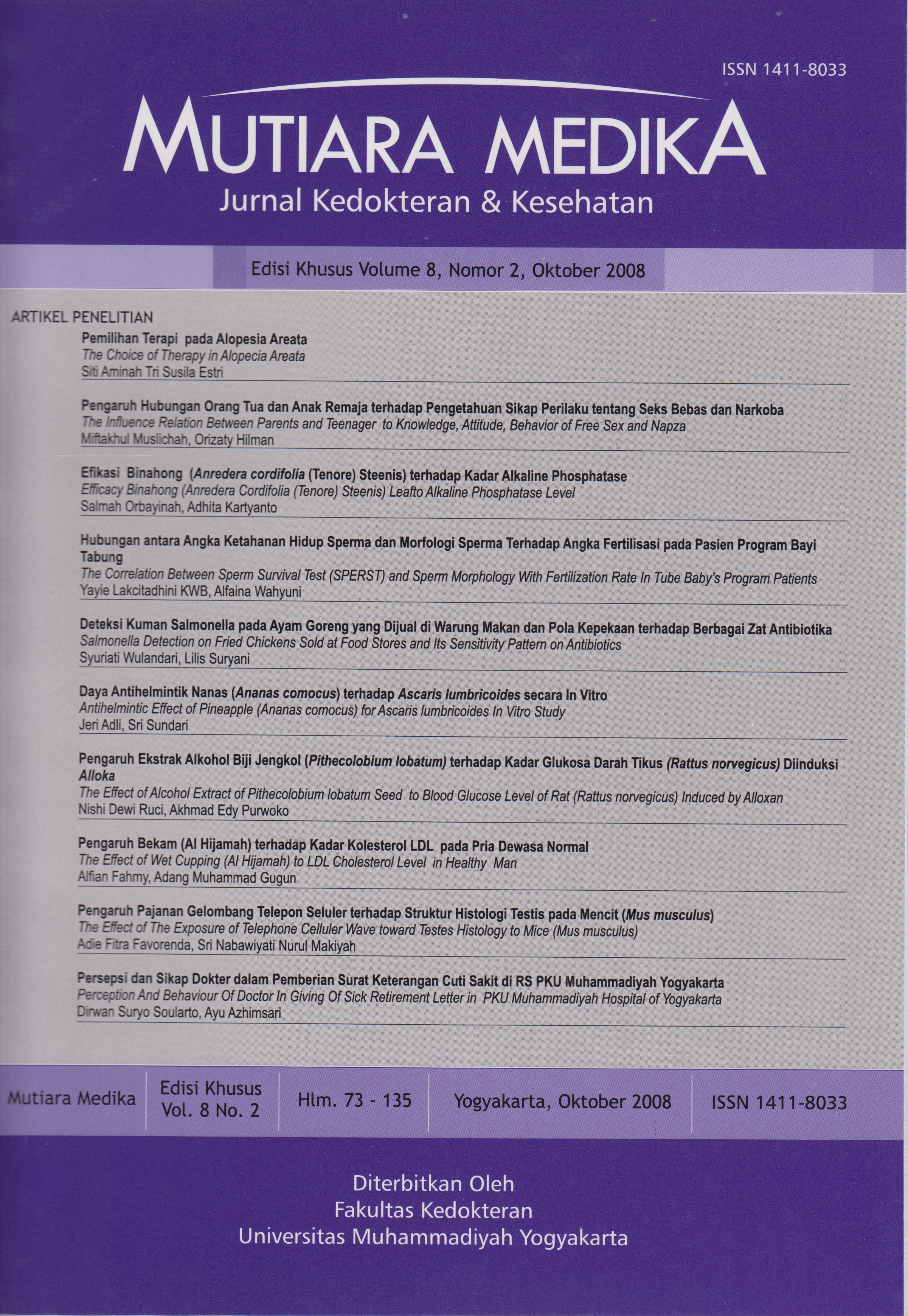Daya Antihelmintik Nanas (Ananas comocus) terhadap Ascaris lumbricoides secara In Vitro
DOI:
https://doi.org/10.18196/mmjkk.v8i2%20(s).1633Keywords:
antihelmintik, Ascaris Lumbricoides, nanas (Ananas comocus), Antihelmintic, Ascaris lumbricoies, Ananas comocus, in vitroAbstract
Ascariasis is one disease with high risk. In long time ago, Indonesian people was using traditional medicine from plant and animal, but nothing study to research it. The aim of this study is to determine the antihelmintic effect ofpineapple for Ascaris. The method of this study is experimental, the collected data with cohort. The sample is ascaris with same size, the gender is woman. The study using Pyrantel Pamoat, NaCl 0,9% and pineapple with any concentration.This research used 8 groups of experiment, they were 6 groups consisted of pineapple in 100%,75%,505,25%,10% and 5% and 2 groups of control used physiological salt and pirantel pamoat 0,236%. Result of this research showed that concentration of pineapple extract 100% there was non significant difference(P>0,05) within pirantel pamoat. Concentration ofpineapple extract 75%,50%,25%,10% and 5% had significant difference(P<0,05) with pirantel pamoat. Probhit analyze is got LD 50 pineapple extract (ananas comocus) is 20.50314% with the boundary gyration of under 13.83529 and boundary gyration to the 30.38451.LD 90 Pineapple extract is 81.05742 with the boundary gyration of under 40.94076 and boundary gyration to the 160.4833.While LD 95 from Pineapple extract is 119.6979 with the boundary gyration of under 52.37216 and boundary gyration to the 273.5727. In conclusion, Pineapple (Ananas comocus) have antihelminthic effect for Ascaris but the dose more better than Pyrantel Pamoat.
Ascariasis adalah salah satu penyakit dengan resiko tinggi. Sejas dahulu kala orang Indonesia memakai obat tradisional dari tanaman dan hewan tetapi belum ada penelitian yang mengkaji hal tersebut. Tujuan penelitian ini adalah untuk mengkaji efek antihenmintik buah nanas terhadap Ascaris lumbricoies. Desain penelitian adalah eksperimental dengan data dikoleksi secara cohort. Sampel adalah Ascaris dengan ukuran dan jenis kelamin sama yaitu betina. Penelitian dengan Pyrantel Pamoat, NaCl 0,9% dan buah nanas dalam beberapa konsentrasi. Ada 8 kelompok yaitu 6 kelompok buah nanas dengan konsentrasi 100%,75%,505,25%,10% dan 5%, serta 2 kelompok control dengan garam fisiologis dan pirantel pamoat 0,236%. Hasil penelitian menunjukkan bahwa buah nanas 100% tidak berbeda bermakna (p>0,05) dengan pirantel pamoat, buah nanas konsentrasi 75%,50%,25%,10% dan 5% berbeda bermakna (p<0,05) dengan pirantel pamoat. Hasil analisis Probit menunjukkan bahwa. Lethal Dosis 50 (LD 50) perasan nanas adalah 20.50314%. Lethal Dosis 90 (LD 90) perasan nanas adalah 81.05742%. Lethal Dosis 95 (LD 95) perasan nanas adalah 116.6979. Dapat disimpulkan bahwa perasan nanas (Ananas comocus) mempunyai daya antihelmintik terhadap Ascaris lumbricoides.
References
Soedarto. (1990). Penyakit-penyakit Infeksi di Indonesia, Surabaya : Widya Medika.
International Relief and Development. (2004). Laporan Pencegahan dan Pemberantasan Cacingan. Jakarta.
Bariah, S. (1998). Aspek Epidemiologi Infeksi Soil Transmitted Helminths di Indonesia. Seminar Sehari dan Penanggulangannya Infeksi Soil Transmitted Helminths. Surabaya.
Anonim a. (2002, 12 April). Pemberantasan Cacingan Harus Dilakukan Kontinu. Kompas Cyber Media, Artikel. Diakses 13 April 2007, dari http://www.kompas.com/kompas- cetak/0209/10/daerah/dana25.htm
Departemen Kesehatan RI. (1981). Pemanfaatan Tanaman Obat, Edisi II, Jakarta.
Mulyaningsih, B. (1987). Khasiat Rimpang Temulawak (Curcumae Rhizoma) Terhadap Cacing Tambang Anjing Secara In Vitro, Laporan Penelitian UGM, Yogyakarta.
Sastroamijoyo, S. (1988). Obat Aseli Indonesia. Jakarta: PT. Dian Rakyat.
Heyne, K. (1994). Tumbuhan Berguna Indonesia. Badan Litbang Departemen Kehutanan RI. Jakarta.
Downloads
Published
Issue
Section
License
Copyright
Authors retain copyright and grant Mutiara Medika: Jurnal Kedokteran dan Kesehatan (MMJKK) the right of first publication with the work simultaneously licensed under an Attribution 4.0 International (CC BY 4.0) that allows others to remix, adapt and build upon the work with an acknowledgment of the work's authorship and of the initial publication in Mutiara Medika: Jurnal Kedokteran dan Kesehatan (MMJKK).
Authors are permitted to copy and redistribute the journal's published version of the work (e.g., post it to an institutional repository or publish it in a book), with an acknowledgment of its initial publication in Mutiara Medika: Jurnal Kedokteran dan Kesehatan (MMJKK).
License
Articles published in the Mutiara Medika: Jurnal Kedokteran dan Kesehatan (MMJKK) are licensed under an Attribution 4.0 International (CC BY 4.0) license. You are free to:
- Share — copy and redistribute the material in any medium or format.
- Adapt — remix, transform, and build upon the material for any purpose, even commercially.
This license is acceptable for Free Cultural Works. The licensor cannot revoke these freedoms as long as you follow the license terms. Under the following terms:
Attribution — You must give appropriate credit, provide a link to the license, and indicate if changes were made. You may do so in any reasonable manner, but not in any way that suggests the licensor endorses you or your use.
- No additional restrictions — You may not apply legal terms or technological measures that legally restrict others from doing anything the license permits.






